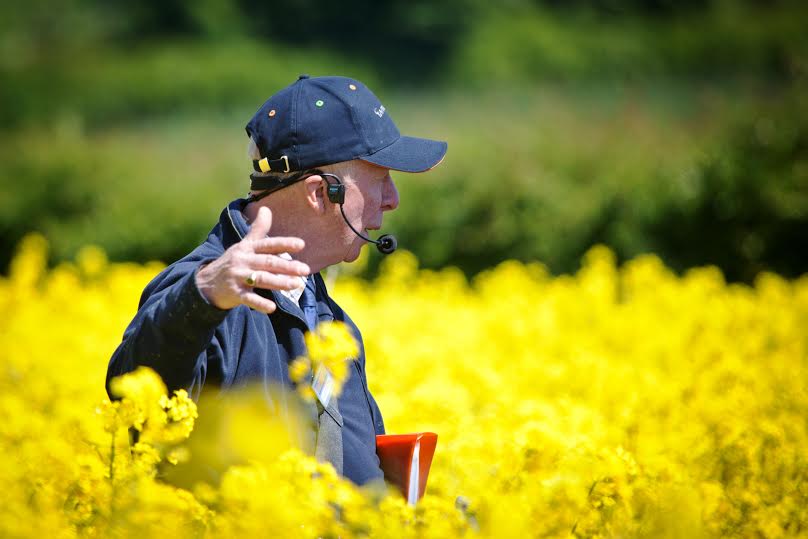
Oilseed Rape is frequently called the “banker crop” on most arable farms, and is probably the best autumn-planted rotational break crop and entry for 1st wheat.
The unknown is what its actual value might be when the crop is marketed says Colin Button, Hutchinsons seed manager, as he examines the place and importance of OSR as a crop option for UK farmers this autumn.
"This time last year, the price indicators showed wheat around £140/t and oilseed rape hovering in the low £200’s.
"In the face of the low potential returns and the anticipated establishment difficulties from Cabbage Stem Flea Beetle (CSFB) attack, many growers have decided to reduce the rape area they planted," he says.
The AHDB autumn 2015 planted area survey figures now shows a reduction in planted rape area of 10% to 548,000Ha (vs 2015 harvest area of 611,000Ha).
"What we now know is that wheat prices have fallen dramatically and there has been an improvement in rapeseed values which, when added to oil bonuses, makes the OSR crop look much more attractive than could have been anticipated a year ago."
"In fact OSR is approaching 2.5 times the value of wheat - a rule of thumb which was always said to govern where the crop price should be to justify its place in a farm’s crop rotation."
Viewing crop choices
Mr Button feels that with this change of crop values, now could be the right time to look ahead to harvest 2017 and put OSR back in place as the key autumn-planted rotational crop.
The establishment challenges remain, especially in the CSFB hot-spots.
"However, away from these specific areas, if given close attention to best practice over soil management pre-drilling, soil moisture preservation and a little luck, it is possible for the majority of the national crop to be successfully established."
The potential gross margin returns for OSR give a clear picture of where winter OSR sits, alongside the other options (all figures based on likely crop values for 2017 harvest from information taken in early March 2016).
Conventional or Hybrid?
Once the decision is made to grow the crop, the question which follows is "Which varieties would be my best option? Should I go for a conventional type, or opt to choose a hybrid?"
There are very good reasons to consider both, adds Mr Button. He points out that the yield potential of conventional varieties has kept pace with hybrids in the AHDB Recommended List year on year.
But he suggests looking into the establishment criteria and there are several varieties which are clear leaders and arise from within both types.
"Vigour through the germination and establishment phases can make all the difference.
"In our own RTC site observations, the hybrids Incentive, Wembley, SY-Harnas, Fencer and Harper have stood out particularly. Indeed Fencer has shown to be the most vigorous, whether sown early or late (second week of September).
"The conventional varieties Campus and Elgar have also shown good vigour.
"Campus in particular, is the outstanding variety and is in fact the widest grown conventional variety planted for harvest 2016 - a testament to the faith that growers had in their choice for the year’s crop in the face of the establishment uncertainties.
"Its verticillium wilt tolerance, as tested in the breeder’s trials, also makes the variety a continued stable, reliable choice.
"We should recognise that Elgar tops the new list and is, with its ratings for gross output, lodging, oil and disease scores a potentially choice variety. Sitting alongside a proven variety like Campus, it will be one to consider growing.
"Although the 2015 Recommended List pushed Elgar to the front, it has previously seen some variability in performance – I would advise some caution before making major changes in variety selections."
Care with seed rates
Mr Button adds that an additional consideration in the choice between hybrids and conventional varieties is their seed rate for successful establishment.
"The hybrids normally require approximately 1.5 million seeds for 3 ha’s (around 50 seeds/m2) versus the 4 million seed packs of conventional types (>100 seeds/m2).
"On the face of it, the conventional type and higher seed rates will provide more seed and therefore a denser plant-stand in the field.
"The conventional seed rates, perhaps, could be pushed a little further from 4 ha’s to drill across 5 ha’s.
"However, it would be wise not to gamble and risk variable establishment, especially if conditions immediately after drilling become dry or CSFB attacks deplete the crop stand."
